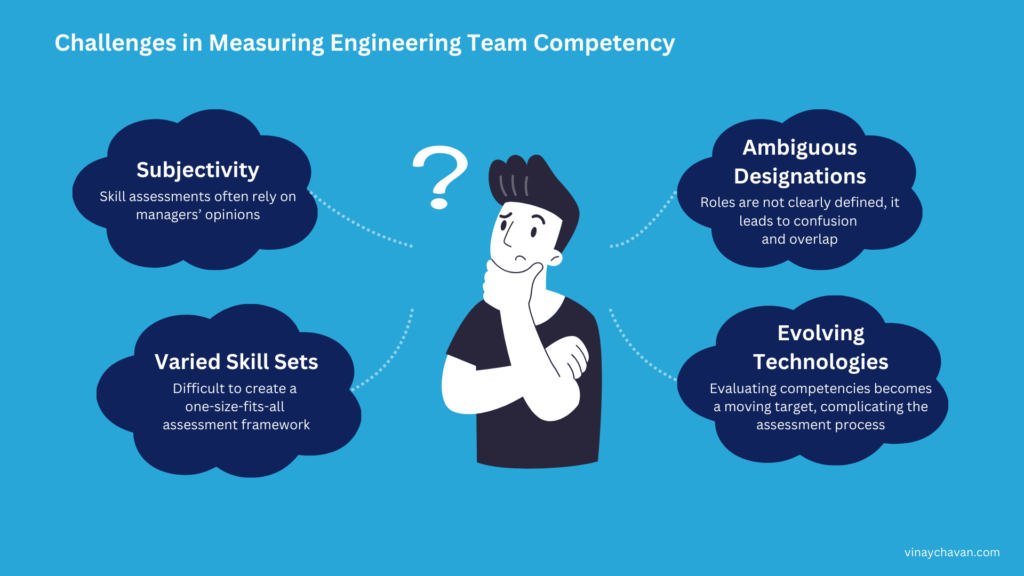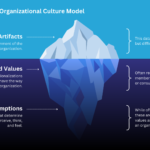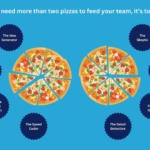In the ever-evolving field of software engineering, it’s essential to keep teams performing at their best and continuously improving. One effective strategy to achieve this is through the use of a competency matrix. In this article we’ll discuss the challenges of objectively assessing individual skills, the benefits of standardizing roles, and how a competency matrix can help identify and bridge skill gaps through strategic hiring and development programs. Additionally, we’ll discuss how integrating this matrix into Objectives and Key Results (OKRs) for engineering managers can boost overall team performance.
Challenges in Measuring Team Competency

Measuring individual competency within a diverse engineering team is fraught with challenges. One of the primary issues is subjectivity. Performance reviews and skill assessments often rely on managers’ opinions, which can vary widely. This subjectivity can lead to inconsistencies, as different managers might have different criteria for what constitutes proficiency in a particular skill.
Another significant challenge arises from ambiguous designations given based on age instead of skills. When roles and responsibilities are not clearly defined, it leads to confusion and overlap. For instance, if the distinction between a “software engineer” and a “senior software engineer” is not clear, it becomes difficult to set appropriate expectations and evaluate performance accurately. This ambiguity can cause frustration among team members who are unsure of their specific duties and career progression paths.
The varied skill sets present within a team add another layer of complexity. Engineering teams comprise individuals with different roles and areas of expertise, making it difficult to create a one-size-fits-all assessment framework. For instance, the competencies required for a front-end developer are vastly different from those needed for a back-end engineer or a DevOps specialist. This diversity necessitates a flexible yet standardized approach to competency measurement.
Furthermore, the rapid evolution of technology adds another layer of complexity. Technologies and best practices in software engineering are continually advancing, requiring engineers to engage in continuous learning and adaptation. As new tools and methodologies emerge, evaluating competencies becomes a moving target, complicating the assessment process.
Building Competency Matrix
1. Standardize Designations and Roles
To effectively create a competency matrix, it’s essential to standardize job designations within the team. This begins with defining roles and responsibilities. Clearly outlining what is expected from each role helps in setting precise performance benchmarks. A huge shoutout to Sarah Drasner (@sarah_edo) for her career ladders! This framework is an excellent foundation for standardizing team designations based on roles rather than technology-specific titles as follows,
- Engineer I
- Engineer II
- Senior Engineer
- Staff Engineer
- Principal Engineer
- Distinguished Engineer
2. Identify Key Competencies
Next, it’s crucial to create skill categories. Skills can be broadly divided into technical and non-technical areas. Technical skills might include proficiency in programming languages, familiarity with development tools, and knowledge of specific frameworks. Non-technical skills, on the other hand, encompass abilities like effective communication, problem-solving, and teamwork. By categorizing skills, organizations can ensure a holistic approach to competency evaluation. Example,
| General Skills | Web Frontend | Backend | Mobile | QA Automation | Testing Areas |
|---|---|---|---|---|---|
| Attention to Detail | Typescript | Typescript | Typescript | Selenium | Database/SQL |
| Communication | React JS | NodeJS | ReactNative | Appium | API Testing |
| Problem-Solving | Redux | Express | Expo | Cypress | Performance Testing |
| Time Management | Jest/Mocha | Jest/Mocha | App Store | TestComplete | Security Testing |
| QC Standards | SQL | Play Store | Katalon Studio | ||
| Teamwork | MongoDB | ||||
| Agile and Scrum | DynamoDB | ||||
| Documentation |
3. Establish Proficiency Levels
Lastly, establishing proficiency levels is key to standardization. Proficiency levels such as novice, intermediate, and expert provide a clear progression path for skill development. For instance, a novice in cloud computing might understand basic concepts, an intermediate might be able to deploy applications, and an expert might design and manage complex cloud architectures. These levels help in setting clear expectations and growth paths for team members.
| Skill Level | Description | Level |
|---|---|---|
| – | Not applicable / missing | 0 |
| Novice | Requires hand holding and supervision | 1 |
| Intermediate | does not require hand-holding but requires supervision for complex problems | 2 |
| Expert | no supervision required, can teach others | 3 |
Implementing a Competency Matrix
1. Set Up the Excel Sheet
- Open Excel: Start by opening a new Excel workbook.
- Label Rows and Columns: In the first row, list the key competencies across the columns (e.g., A1: Programming Languages, B1: Database Management, C1: Problem-Solving). In the first column, list the names of the team members down the rows (e.g., A2: John Doe, A3: Jane Smith).
- Define Proficiency Levels: Determine the proficiency levels you will use (e.g., 1 for novice, 2 for intermediate, 3 for expert). You can add a legend or key to explain these levels, perhaps in a cell near the top of the sheet.
Here’s a simple example to illustrate how your matrix might look:
| Programming Languages | Database Management | Problem-Solving | Communication | |
|---|---|---|---|---|
| John Doe | ||||
| Jane Smith | ||||
| Alice Johnson | ||||
| Bob Brown |
2. Populate the Matrix
- Assess Competencies: Once key competencies are identified, the next step is to assess current skill levels within the team. This can be done through self-assessments, peer reviews, and practical evaluations. Standardized tests or coding challenges can also be used to validate these assessments. For instance, team members might rate their proficiency in different areas, followed by peer reviews to cross-verify these ratings. This multi-faceted approach helps in creating an accurate picture of the team’s current skill set.
- Add Team and Employee Versatility: Apply the formula such that the individual team member gets a single score in percentage for the overall competencies defined as well as for each competency column for the team. In the table below those are shown as Individual Versatility and Team Versatility respectively.
| Team Coverage: 100% | Skills ▶︎ | Javascript | Typescript | React | React Native | Node | |
| Team Versatility ▶︎ | 100% | 75% | 75% | 75% | 100% | ||
| Name | Designation | Employee Versatility ▼ | |||||
| John Doe | Staff Engineer | 100% | 3 | 3 | 3 | 3 | 3 |
| Jane Smith | Senior Engineer | 93% | 3 | 2 | 3 | 3 | 3 |
| Alice Johnson | Engineer II | 80% | 3 | 2 | 2 | 2 | 3 |
| Bob Brown | Engineer I | 67% | 3 | 2 | 1 | 1 | 3 |
Leveraging the Competency Matrix
With the establishment of the competency matrix, you now have a clear, objective perspective on the team’s skill levels and proficiencies. This tool allows you to accurately gauge the distribution of competencies across various roles and designations within the team. By utilizing the competency matrix, you can identify existing skill gaps and assess the overall efficiency and utilization of your team’s capabilities. This comprehensive overview offers invaluable insights for targeted skill development and strategic resourcing, ensuring that each team member is positioned to contribute effectively to the organization’s goals.
- Analyze Skill Gaps – With the current competencies assessed, the next step is to analyze skill gaps. By comparing current skill levels with the required competencies, organizations can identify areas where team members need improvement or where new skills are necessary. For example, if the team lacks expertise in a new technology that the organization plans to adopt, this gap can be highlighted for targeted development.
- Develop Learning and Development Programs – To address identified skill gaps, it’s crucial to develop targeted learning and development programs. These programs might include workshops, online courses, and mentorship initiatives. Encouraging continuous learning is key to keeping the team updated with the latest technological advancements. For instance, organizing regular coding boot camp or subscribing to online learning platforms can help team members enhance their skills.
- Hiring to Fill Gaps – When internal development isn’t sufficient to address all skill gaps, it’s essential to hire new team members with the required competencies. The competency matrix can guide the hiring process by pinpointing specific skills that are lacking within the team. For example, if there’s a gap in cybersecurity expertise, the recruitment process can focus on candidates with strong backgrounds in this area, ensuring a balanced and well-rounded skill set within the team.
- Cutting the Weeds – A crucial yet often uncomfortable aspect of leveraging a competency matrix is identifying team members who may be slowing down the team’s progress. By objectively assessing each individual’s skills and performance, the matrix can reveal those who consistently fall short of the required competencies. This transparency allows engineering managers to make informed decisions about whether to provide additional support and training to these individuals or, in some cases, to consider more drastic measures such as reassigning roles or even termination. The ultimate goal is to ensure that every team member contributes effectively to the team’s success and that underperformance is addressed promptly to maintain overall productivity and morale.
Integrating Competency Matrix into OKRs
To ensure that the competency matrix makes a tangible impact, it should be integrated into the OKRs for engineering managers. This integration involves several steps:
- Setting Clear Objectives – First, define specific objectives related to skill development and competency improvement. These objectives should be clear and measurable. For instance, an objective could be to “Increase the team’s proficiency in cloud technologies by 20% over the next quarter.” Such objectives provide a clear direction for skill enhancement efforts.
- Tracking Key Results – Next, measure progress through key results. Key results could include the number of completed training sessions, improvements in competency assessments, or the successful implementation of new technologies. Regularly reviewing and adjusting OKRs based on the team’s evolving needs and achievements helps in maintaining focus and momentum. For example, tracking the number of team members who have completed advanced cloud certification courses can provide tangible evidence of progress.
- Continuous Update and Feedback – Finally, it’s important to regularly update the competency matrix to reflect new skills and technologies. Encouraging feedback from team members helps in refining the matrix and training programs continuously. For instance, as new technologies become relevant, the competency matrix should be updated to include these skills. Regular feedback sessions can also help in identifying any gaps or areas for improvement in the training programs.
Benefits of a Competency Matrix to an Organization
Implementing a competency matrix offers several advantages across the organization on how other departments such as HR function because of this:
- Objective Measurement – A competency matrix provides a clear and objective framework for evaluating skills and competencies. By standardizing assessments, organizations can minimize subjectivity and ensure consistent evaluations across the team. This objectivity helps in making fair and informed decisions about promotions, role assignments, and development needs.
- Targeted Development – With a competency matrix, organizations can implement focused training and development initiatives. By identifying specific skill gaps, resources can be allocated efficiently to areas that need the most attention. This targeted approach ensures that training programs are relevant and impactful, leading to a more skilled and capable team.
- Improved Performance – Addressing skill gaps through targeted development leads to improved team performance. Teams become more proficient and capable of handling complex projects, resulting in higher-quality deliverables and increased productivity. For instance, a team with enhanced cloud computing skills can more effectively leverage cloud technologies, leading to better project outcomes.
- Enhanced Hiring – A competency matrix guides the hiring process by highlighting specific skills that are lacking within the team. This helps in bringing in new team members with the required competencies, ensuring a balanced and well-rounded skill set. By aligning hiring decisions with the competency matrix, organizations can build a team that is better equipped to meet current and future challenges.
Conclusion
A competency matrix is a powerful tool for enhancing the performance of engineering teams. By standardizing designations, identifying skill gaps, and implementing targeted learning and development programs, organizations can foster a culture of continuous improvement. Integrating this matrix into the OKRs for engineering managers ensures that competency development aligns with overall team performance goals. This alignment leads to a more skilled, adaptable, and successful engineering team, capable of meeting the dynamic demands of the software engineering landscape.

